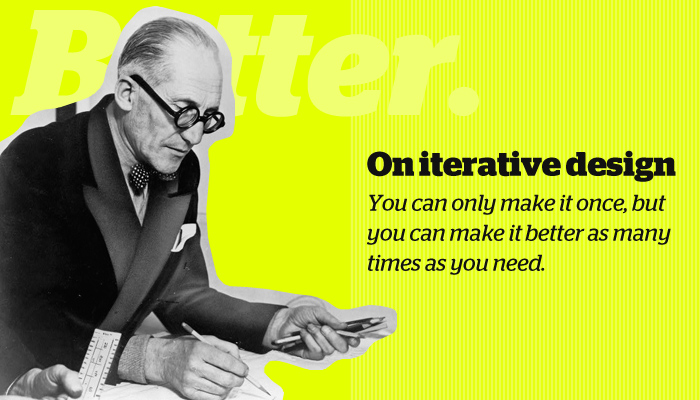Iterative design is a methodology that repeatedly comes up in discussions about creating digital experiences.
It’s a powerful – and increasingly common – method for developing websites and apps, and it’s at the core of current ideas about effective digital marketing.
So what exactly is iterative design?
Iterative design is a methodology that positions your digital experience is a living project that you should regularly tweak and improve upon as you go, rather than building it in one fell swoop and being done for good.
You can think of the iterative design process as a continuous cycle of prototyping, testing, and making adjustments and refinements.
So rather than building an entire enterprise website from start to finish without any testing or user feedback – like you would do if you were using the traditional waterfall methodology – iterative design is an ongoing, incremental process.
One part of a digital experience is designed, created, and tested, and is built upon in future designs.
 Image via ZURB
Image via ZURB
It might sound complex, but it’s a process you’ve likely encountered before without even realizing it.
Think of a wiki. A wiki is a website that is developed incrementally by a community of users who work collaboratively to shape the content. Any user can add or edit content at any time – so wikis are constantly evolving as people fine-tune their pages and make small modifications.
A wiki is never going to be a ‘finished product’ and that’s part of what makes it so valuable. It’s infinitely adjustable to make room for new inputs and new knowledge.
Iterative design is also easy to spot in the offline world.
Common Law, for example, uses the principle of legal precedent. It builds on past experience, and cases, essentially making the law a form of iterative design. There’s a clear and incremental trail of development, and it is constantly being shaped.
So why is iterative design so in vogue in marketing and web design philosophy today? The short answer is that it works.
Our experience – and a mountain of data – has shown that approaching design iteratively leads to the most effective and most efficient results.
4 Reasons to use iterative design
Here are our top 4 reasons to love iterative design.
1. It provides robust user feedback

One of the major benefits of iterative design is that, by its nature, it involves a lot of user testing.
All this testing amounts to what is essentially a huge resource of user feedback that can be used to improve your website’s design, usability and, ultimately, your overall customer experience.
User testing and feedback can help you understand which elements of your site are working and which aren’t. It can also help you find the root cause to problems you may know exist, but not know why they do.
For example, if an ecommerce site is seeing a spike in abandonment at a certain screen in the user journey, site owners likely know where the problem is, but not why it's happening.
User testing can be very helpful with that.
2. It can catch problems earlier
The cycle of prototyping, testing, and refining is great for raising a red flag for any potential problems early on in the design process, rather than at the very end.
This can save you from a costly, time-consuming redesign down the line.
3. It measurably improves usability
In addition to catching problems, the iterative design process can give you a clear path to improvement.
The more your digital experience is tested and refined, the more usable it’s going to be.
Studies have found that iterative design improves usability across a number of metrics, including overall user satisfaction rate, number of usability problems, and time taken to complete tasks scenarios.
4. It’s efficient and cost-effective
Given all the testing and continuous improvement, iterative design might sound costly and time-consuming. But it’s more efficient in two significant ways.
First, iterative design allows you to spend less time making documents that describe and lay out the design than you would in a traditional waterfall approach. Instead, you design as you go and ultimately spend more time designing and working on the product.
Second, fixing problems and performing maintenance is more efficient with iterative design. Since you fix and improve as you go, you avoid falling into a situation where you have to do a large overhaul of your website. Instead, iterative design helps you stay on top of changes that need to be made as they come up.
 Image via InnovationLabs
Image via InnovationLabs
Conclusion
Iterative design is a powerful tool to have in your design arsenal. By approaching your website or app as a living and evolving project rather than something static, you can consistently improve upon it.
The cycle of prototyping, testing, and refining that’s at the core of iterative design offers numerous benefits:
- Testing gives you a valuable collection of user feedback that you can use to improve your site and to understand what’s working for you
- It helps you catch problems before they spiral out of control
- It improves usability across key metrics
- It’s more efficient than your traditional waterfall approach
And that’s why we love iterative design.
